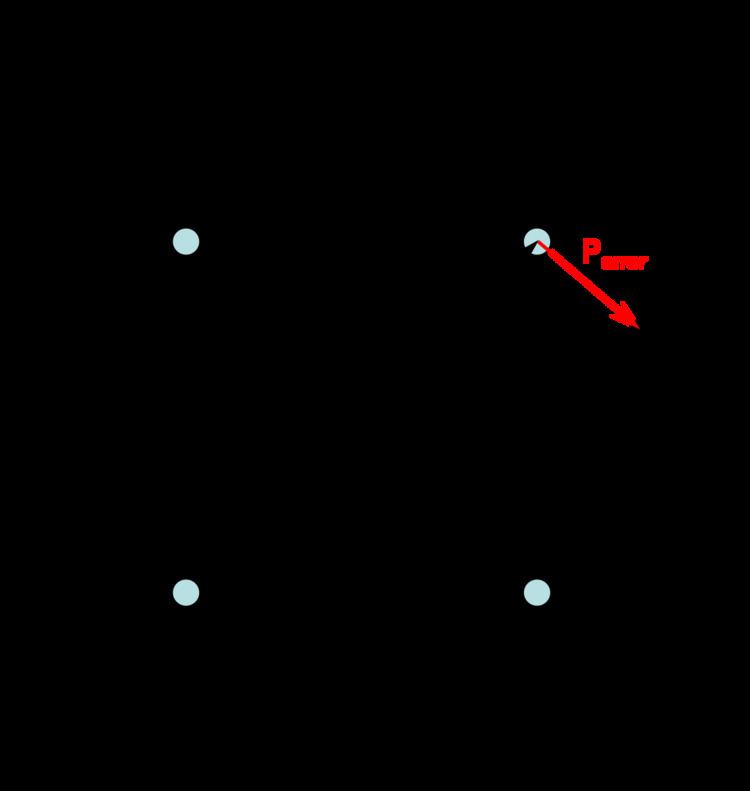 | ||
The error vector magnitude or EVM (sometimes also called receive constellation error or RCE) is a measure used to quantify the performance of a digital radio transmitter or receiver. A signal sent by an ideal transmitter or received by a receiver would have all constellation points precisely at the ideal locations, however various imperfections in the implementation (such as carrier leakage, low image rejection ratio, phase noise etc.) cause the actual constellation points to deviate from the ideal locations. Informally, EVM is a measure of how far the points are from the ideal locations.
Contents
Noise, distortion, spurious signals, and phase noise all degrade EVM, and therefore EVM provides a comprehensive measure of the quality of the radio receiver or transmitter for use in digital communications. Transmitter EVM can be measured by specialized equipment, which demodulates the received signal in a similar way to how a real radio demodulator does it. One of the stages in a typical phase-shift keying demodulation process produces a stream of I-Q points which can be used as a reasonably reliable estimate for the ideal transmitted signal in EVM calculation.
Definition
An error vector is a vector in the I-Q plane between the ideal constellation point and the point received by the receiver. In other words, it is the difference between actual received symbols and ideal symbols. The average amplitude of the error vector, normalized to peak signal amplitude, is the EVM. For the percentage format, root mean square (RMS) average is used.
The error vector magnitude is equal to the ratio of the amplitude of the error vector to the root mean square (RMS) amplitude of the reference. It is defined in dB as:
where Perror is the RMS amplitude of the error vector. For single carrier modulations, Preference is, by convention, the amplitude of the outermost (highest power) point in the reference signal constellation. More recently, for multi-carrier modulations, Preference is defined as the reference constellation average power.
EVM is defined as a percentage in a compatible way:
with the same definitions.
EVM, as conventionally defined for single carrier modulations, is a ratio of a mean amplitude to a peak amplitude. Because the relationship between the peak and mean signal power is dependent on constellation geometry, different constellation types (e.g. 16-QAM and 64-QAM), subject to the same mean level of interference, will report different EVM values.
EVM, as defined for multi carrier modulations, is arguably the more satisfactory measurement because it is a ratio of two mean powers and is insensitive to the constellation geometry. In this form, EVM is closely related to Modulation error ratio, the ratio of mean signal power to mean error power.
Dynamic EVM
Battery life and power consumption are important considerations for a system-level RF transmitter design. Because the transmit power amplifier (PA) consumes a significant portion of the total system DC power, a number of techniques are employed to reduce PA power usage. Many PAs offer an adjustable DC supply voltage to optimize the maximum RF output power level versus its DC power consumption. Also, most PAs can be powered-down or disabled when not in use to conserve power, such as while receiving or between packets during transmission. In order to maximize power efficiency, the PA must have fast turn-on and turn-off switching times. The highest DC power efficiency occurs when the time delta between PA Enable and the RF signal is minimized, but a short delay can exacerbate transient effects on the RF signal.
Because the power-up/power-down operation of the PA can cause transient and thermal effects that degrade transmitter performance, another metric called Dynamic EVM is often tested. Dynamic EVM is measured with a square wave pulse applied to PA Enable to emulate the actual dynamic operation conditions of the transmitter. The degradation in dynamic EVM is due to the PA transient response affecting the preamble at the start of the packet and causing an imperfect channel estimate. Studies have shown that dynamic EVM with a 50% duty cycle square wave applied to PA Enable to be worse than the static EVM (PA Enable with 100% duty cycle).
